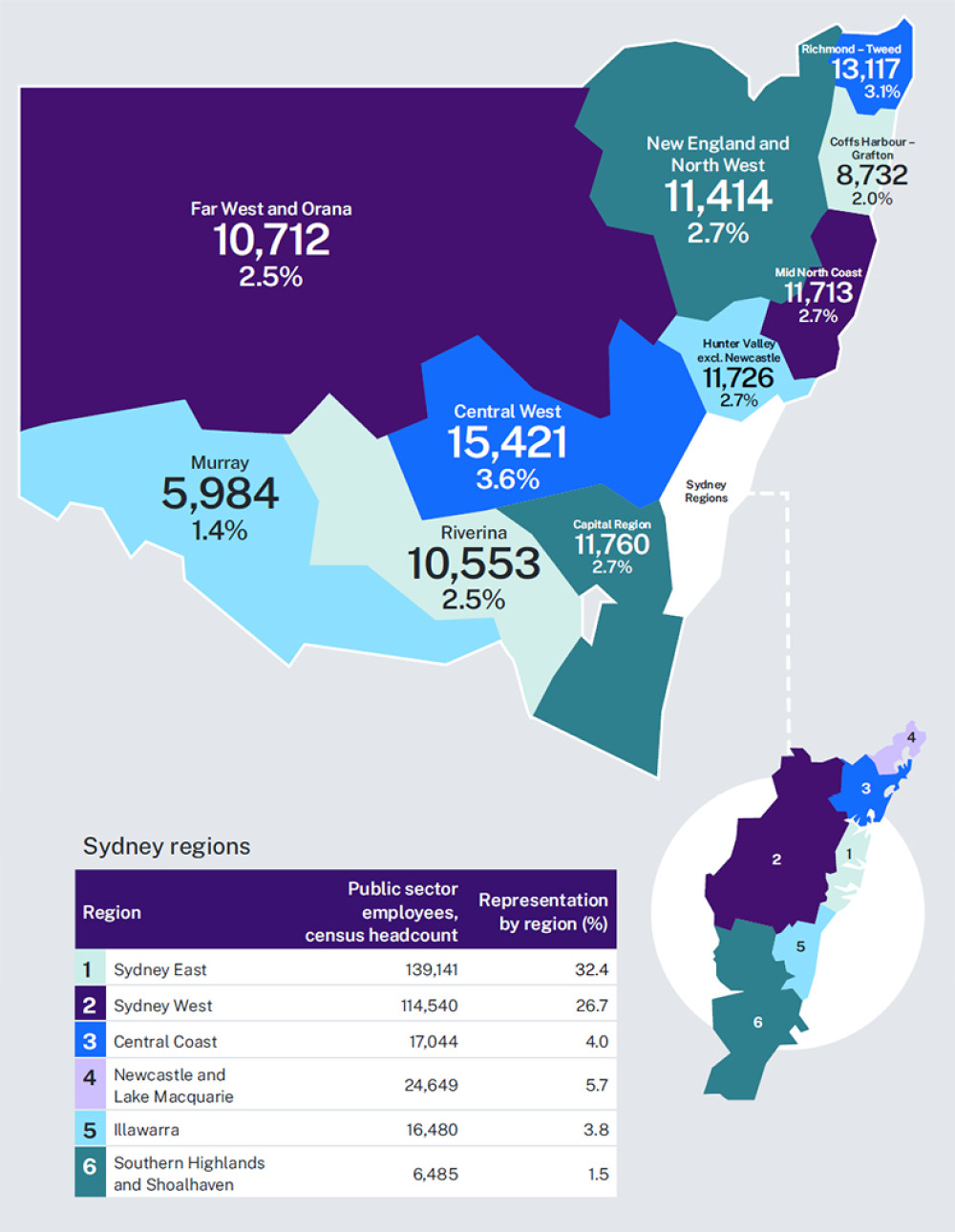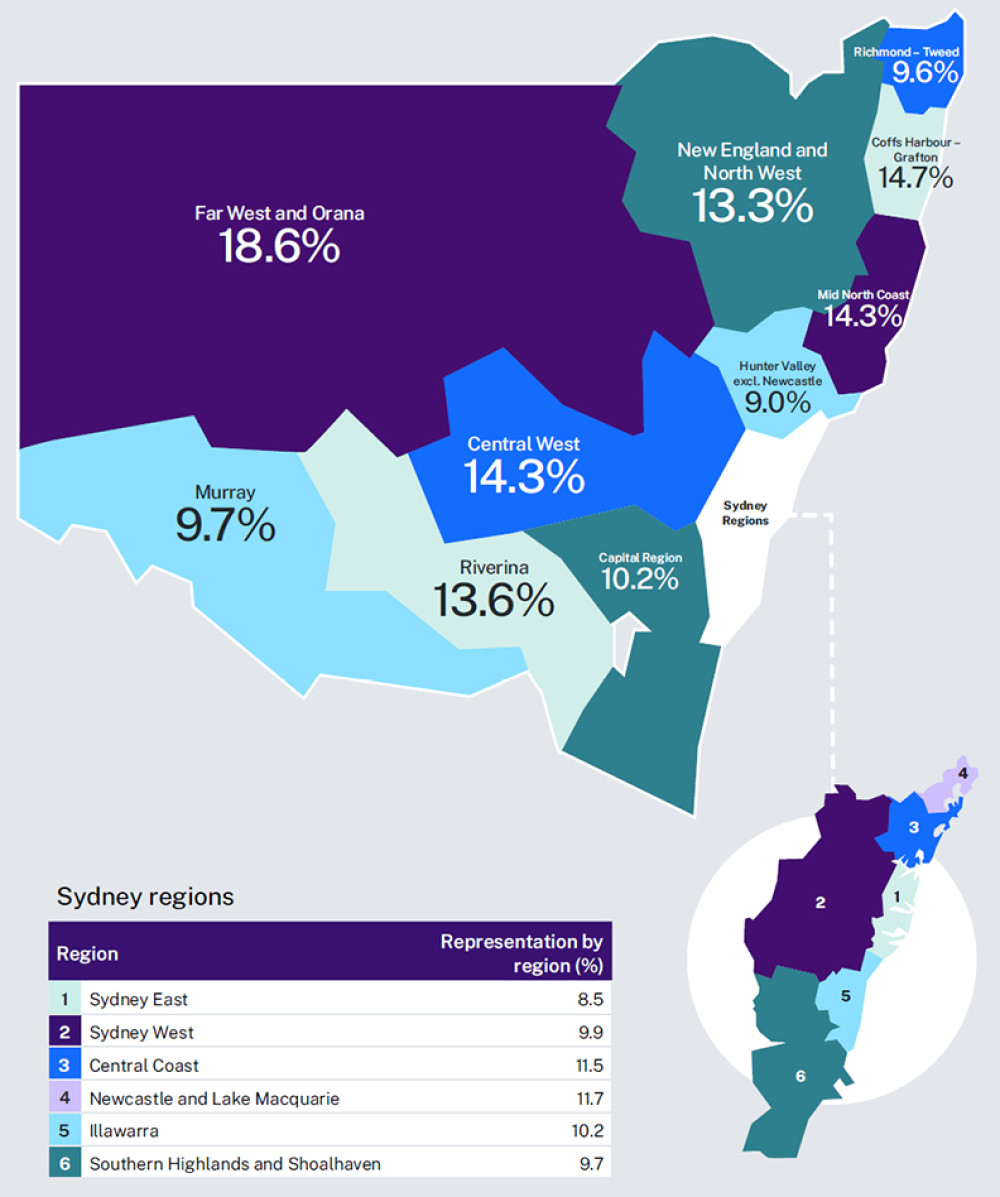34.3% (same as 2021)
of employees were located in regional areas at census date
40.9%
of employees were located outside Sydney at census date
The NSW public sector is the largest employer in Australia, accounting for more than 10% of employment in the state. While most roles are in metropolitan areas, the NSW public sector provides a significant proportion of all employment in regional NSW.1
This analysis is based on employees’ work locations in the Workforce Profile data submitted by departments and agencies. It does not reflect any work-from-home arrangements that were part of the response to the pandemic.
In 2022, 34.3% (+249 headcount) of public sector employees worked in regional areas. All Sydney local government areas (LGAs) as well as the Newcastle and Wollongong LGAs are classified as metropolitan.
Comparing Sydney with the rest of the state2, 59.1% of NSW public sector employees worked in Sydney (see Figure 11.1, Sydney East and Sydney West combined), a decrease of 0.1PP in 2022 (59.2% in 2021). While most of the public sector workforce was located in Sydney, the proportion of public sector employees working outside Sydney was higher than the proportion of the resident population in these areas (40.9% compared to 39.3%) and has increased since 2021 (+0.8PP from 38.5%).3
Figure 11.1: NSW public sector employees by region, census headcount, 2022

NSW Regions
| Region | Census headcount | Representation by region (%) |
|---|---|---|
| Hunter Valley exc. Newcastle | 11,726 | 2.7 |
| Mid North Coast | 11,713 | 2.7 |
| New England and North West | 11,414 | 2.7 |
| Far West and Orana | 10,712 | 2.5 |
| Coffs Harbour – Grafton | 8,732 | 2.0 |
| Richmond – Tweed | 13,117 | 3.1 |
| Capital Region | 11,760 | 2.7 |
| Riverina | 10,553 | 2.5 |
| Murray | 5,984 | 1.4 |
| Central West | 15,421 | 3.6 |
Sydney regions
| Region | Public sector employees, census headcount | Representation by region (%) |
|---|---|---|
| Sydney East | 139,141 | 32.4 |
| Sydney West | 114,540 | 26.7 |
| Central Coast | 17,044 | 4.0 |
| Newcastle and Lake Macquarie | 24,649 | 5.7 |
| Illawarra | 16,480 | 3.8 |
| Southern Highlands and Shoalhaven | 6,485 | 1.5 |
Regional profiles
The distribution of government sector census period full-time equivalent (FTE) by service and region is shown in Table 11.1. Regions outside Sydney accounted for 39.7%, while Sydney East and Sydney West together accounted for 60.3%. In line with previous years, the highest proportion of employees in the government sector working outside Sydney were in the Teaching Service (44.2%) and the NSW Health Service (42.4%), followed by other Crown services (39.7%), NSW Police Force (35.3%), Public Service (34.7%) and the Transport Service (22.5%).
Table 11.1: Census period FTE by service and region (government sector), 20224
| Work region | Public Service | NSW Health Service | NSW Police Force | Teaching Service | Transport Service | Other Crown services | Total government Sector |
|---|---|---|---|---|---|---|---|
| Capital Region | 2,026 | 3,100 | 663 | 2,203 | 179 | 983 | 9,154 |
| Central Coast | 2,206 | 6,207 | 759 | 3,227 | 146 | 1,562 | 14,107 |
| Central West | 3,297 | 4,246 | 560 | 2,348 | 273 | 1,601 | 12,325 |
| Coffs Harbour – Grafton | 1,190 | 2,689 | 279 | 1,448 | 420 | 838 | 6,864 |
| Far West and Orana | 2,098 | 2,933 | 582 | 1,648 | 271 | 1,160 | 8,691 |
| Hunter Valley exc. Newcastle | 2,475 | 2,324 | 504 | 2,735 | 57 | 1,315 | 9,409 |
| Illawarra | 1,687 | 5,579 | 647 | 2,982 | 360 | 2,035 | 13,289 |
| Mid North Coast | 1,260 | 3,490 | 395 | 2,144 | 62 | 1,338 | 8,689 |
| Murray | 674 | 1,522 | 291 | 1,172 | 118 | 722 | 4,499 |
| New England and North West | 1,669 | 3,226 | 551 | 2,184 | 156 | 1,373 | 9,158 |
| Newcastle and Lake Macquarie | 2,784 | 9,669 | 775 | 3,712 | 301 | 2,326 | 19,565 |
| Richmond – Tweed | 1,136 | 4,832 | 537 | 2,322 | 120 | 1,281 | 10,228 |
| Riverina | 1,430 | 3,285 | 396 | 1,748 | 321 | 1,127 | 8,306 |
| Southern Highlands and Shoalhaven | 949 | 1,804 | 240 | 1,437 | 46 | 730 | 5,206 |
NSW public sector relative to the NSW workforce
The NSW public sector accounted for 10.1% of the approximately 4.3 million people employed in NSW at June 2022.5 This is a 0.3pp decrease from 10.4% last year and reflects the larger rate of growth in employed persons in NSW following its contraction in the earlier stages of the pandemic. In 2022, there were 134,448 more employed persons than in 2021, and 349,309 more employed persons than in 2020.
Analysis of the geographic distribution of NSW public sector employees (including casuals) relative to the overall workforce6 shows where government employment contributed the most to local and regional economies. Figure 11.2 shows that the percentage of employed persons who were NSW public sector employees ranged from 8.5% to 18.6% across the regions in 2022.
Figure 11.3: Public sector employees as a proportion of NSW employed persons by region

NSW Regions
| Region | Percentage |
|---|---|
| Hunter Valley exc. Newcastle | 9.0 |
| Mid North Coast | 14.3 |
| New England and North West | 13.3 |
| Far West and Orana | 18.6 |
| Coffs Harbour – Grafton | 14.7 |
| Richmond – Tweed | 9.6 |
| Capital Region | 10.2 |
| Riverina | 13.6 |
| Murray | 9.7 |
| Central West | 14.3 |
Sydney regions
| Region | Percentage |
|---|---|
| Sydney East | 8.5 |
| Sydney West | 9.9 |
| Central Coast | 11.5 |
| Newcastle and Lake Macquarie | 11.7 |
| Illawarra | 10.2 |
| Southern Highlands and Shoalhaven | 9.7 |
Employees
Table 11.2: Impact on regions if all Public Service employees work from home, census headcount, 2022
| Region (ABS Statistical Areas 4) | Employees living in region | Employees working in region | Change if all employees work from home, 2022 |
|---|---|---|---|
| Capital Region | 2,704 | 2,524 | 180 |
| Central Coast | 4,019 | 2,584 | 1,435 |
| Central West | 4,120 | 4,021 | 99 |
| Coffs Harbour – Grafton | 1,632 | 1,471 | 161 |
| Far West and Orana | 2,469 | 2,553 | -84 |
| Hunter Valley exc. Newcastle | 2,987 | 3,033 | -46 |
| Illawarra | 3,623 | 2,057 | 1,566 |
| Mid North Coast | 1,878 | 1,600 | 278 |
| Murray | 786 | 957 | -171 |
| New England and North West | 2,234 | 2,045 | 189 |
| Newcastle and Lake Macquarie | 4,228 | 3,310 | 918 |
| Richmond – Tweed | 1,598 | 1,498 | 100 |
| Riverina | 1,861 | 1,840 | 21 |
| Southern Highlands and Shoalhaven | 1,488 | 1,168 | 320 |
| Sydney – Baulkham Hills and Hawkesbury | 2,516 | 323 | 2,193 |
| Sydney – Blacktown | 3,905 | 1,247 | 2,658 |
| Sydney – City and Inner South | 5,007 | 18,893 | -13,886 |
| Sydney – Eastern Suburbs | 2,472 | 1,705 | 767 |
| Sydney – Inner South West | 4,757 | 1,851 | 2,906 |
| Sydney – Inner West | 3,876 | 2,191 | 1,685 |
| Sydney – North Sydney and Hornsby | 3,613 | 2,095 | 1,518 |
| Sydney – Northern Beaches | 1,821 | 411 | 1,410 |
| Sydney – Outer South West | 3,309 | 1,428 | 1,881 |
| Sydney – Outer West and Blue Mountains | 4,676 | 2,925 | 1,751 |
| Sydney – Parramatta | 4,305 | 15,933 | -11,628 |
| Sydney – Ryde | 1,722 | 732 | 990 |
| Sydney – South West | 3,555 | 2,231 | 1,324 |
| Sydney – Sutherland | 2,713 | 564 | 2,149 |
In 2021, Public Health Orders designed to limit the spread of COVID-19 led to a large proportion of NSW public sector employees working from home. Increased levels of working from home continued into 2022, both in the public and private sector. There is insufficient detail available to accurately determine how many employees worked from home full time. However, Table 11.2 demonstrates the location shift if all Public Service employees were working from home. The Public Service was used for this analysis because it has the highest number of office-based employees who may be able to work remotely.
In this scenario, the regions with the largest decreases are Sydney City and Inner South (-13,886) and Parramatta (-11,628), which are the main employment hubs in Sydney. The regions outside Sydney with the highest increases are Illawarra (+1,566), Central Coast (+1,435), and Newcastle and Lake Macquarie (+918).
Notes
1 Regional boundaries are based on the Australian Statistical Geography Standard developed by the Australian Bureau of Statistics. The work locations of 4,419 NSW public sector employees were unknown due to Workforce Profile data collection records missing a postcode and/or suburb name, or employees working outside NSW. These employees have not been included in denominators when calculating percentages.
2 Statistical Area Level 4, Sydney SA4s grouped, excludes ‘Unknowns’ and ‘Outside NSW’. See Regional reference table in Chapter 12 for more detail.
3 Australian Bureau of Statistics (2021) 'ERP by SA2 and above (ASGS 2021), 2001 onwards' Data by Statistical Area 4 , [ABS. Stat Explorer], accessed 29 September 2022.
4 0.8% of census period FTE is not mapped to any Australian Bureau of Statistics’ Statistical Area Level 4 (SA4) for NSW because of postcode and/or suburb data that is missing or outside NSW.
5 Australian Bureau of Statistics (August 2022), ‘Table 1: RM1 - Labour force status by age, labour market region (ASGS) and sex, October 1998 onwards, [time series spreadsheet], Labour Force, Australia, Detailed, accessed 29 September 2022.
6 Including casual employees gives a complete picture of the number of people contributing to the NSW economy and travelling between regions for work.
-
Next chapter
Data sources, conventions and limitations